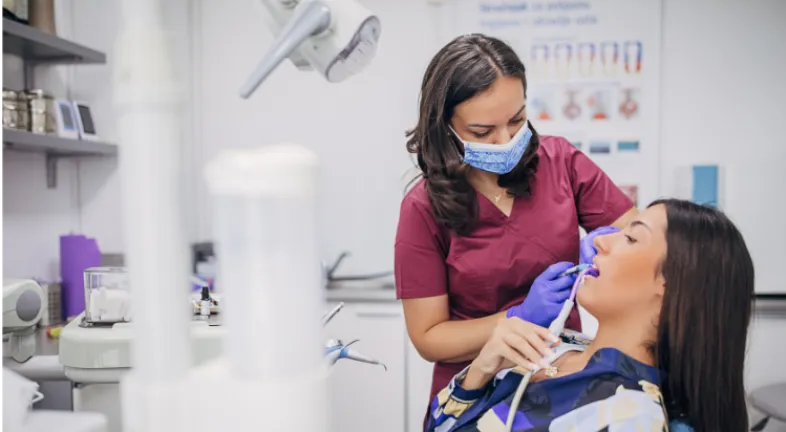
Dentists have long been trying to get the message across that taking care of our teeth and gums is an essential part of healthy living. But, despite that, the number of people attending dental check-ups in the UK has only grown by 20% in the last 20 years; and 43.9% of people have not visited an NHS dentist in the last 24 months. Just over half (58.2%) of children are estimated to visit the dentist as often as they should.
Even if you brush and floss every day, dentists and hygienists are trained to check for dental problems that you may not spot yourself. Without regular dental checks, particularly from an early age, serious dental issues can develop – with one of them being misalignment.
Every set of teeth looks slightly different but for people who have misaligned teeth or jaws there’s a more noticeable difference. Sometimes, only one tooth is affected but other times several teeth or the position of the jaws is involved. The medical term for misaligned teeth is malocclusion also referred to as a bad bite.
Dentists use the term ‘bite’ to describe how your teeth fit together. If your teeth don’t feel as if they fit together correctly, you have speech difficulties, or you grind your teeth at night, you could be suffering from a misaligned bite.
If you suspect you have a bad bite then you should visit a dentist or orthodontist for a professional diagnosis and assessment.
Your dentist or orthodontist will have ways of testing whether your teeth are properly aligned with x-rays and models of your teeth.
Misaligned teeth or jaws can lead to a variety of different problems – but may sometimes cause no problems at all.
According to Healthline, three key types of bites usually cause concern:
Teeth Crowding or Spacing Issues: This kind of bite issue is more obvious because it causes crooked or gappy teeth. The jaw placement and bite itself are usually fairly normal, but orthodontic treatment is needed to correct tooth appearance and spacing.
Overbite: It’s normal for the top teeth to slightly overlap the bottom, but some patients have such a significant overlap that their teeth graze their gums or lips. Most ‘normal’ overlaps are just 1mm – 2mm so anything bigger than this is likely to be causing some issues.
Underbite: This is where the bottom teeth overlap the top teeth, and the facial symmetry will be impacted by a jaw that protrudes. This is often accompanied by some kind of pain though patients may assume their discomfort is normal.
A crossbite is another kind of underbite but usually only impacts a couple of teeth.
There are other less common kinds of bad bites such as an open bite where the teeth don’t touch while the mouth is closed.
While these conditions may be fairly easy to self-diagnose – their impact might not be.
Aside from affecting self-esteem and confidence, a bad bite can cause numerous other problems.
Even if you don’t have tooth or jaw pain, your bad bite could be causing more issues than you realize. These can include:
Some of these ailments like enamel damage, tooth cavities, and gum disease don’t have obvious symptoms in the early stages but are easily prevented with regular dental check-ups and receiving treatment for the bad bite.
Other issues caused by bad bite are often just adapted to, for example, someone who experiences difficulty swallowing has usually just accepted it as “being the way they are” and modified how they eat to suit.
People with a bad bite often have non-dental symptoms, for example, headaches because their bite causes them to hold their mouth and jaw in a way that places tension on the muscles. While this technique is not foolproof, Dr Lowder from the University of Utah’s School of Dentistry recommends people look up towards the ceiling and tap or bite their teeth together, and then do the same while looking down. If the bite feels noticeably different between the positions, there may be additional pressure being placed on the jaw that is causing mild or severe headaches.
Headaches are commonly overlooked as a symptom of bad bites because many people just accept them as a part of life without looking deeply into their cause.
Orthodontic treatment is mainly recommended when the teeth or jaws are more than a little misaligned. For example, if the upper front teeth stick out over the lower front teeth by more than 3 millimeters, or if teeth at the side of the mouth don’t touch each other when the person bites.
While metal braces are often required for more complex bite problems, they are not the only solution.
More people are turning to clear aligners to correct mild to moderate malocclusion
Clear Aligners are more discreet and comfortable than metal braces and offer an affordable solution.
Some people choose to have orthodontic treatment for minor misalignments, purely because they’re unhappy with the way their teeth look.
Depending on the severity of your misalignment, metal braces cost between £1500-£3000 while aligner treatment from the dentist such as Invisalign will set you back between £1500-5500.
A more affordable option for minor to moderate misalignments is at-home teeth straightening, otherwise known as direct-to-consumer aligners which typically cost between £1000 and £1600.
The good news is that Caspersmile is an even cheaper solution, allowing those with minor to moderate misalignments to fix their teeth and improve their oral and general health for a one-off payment of £625 (currently on discount).
First, you’ll complete a short online assessment to determine if you are likely to be a candidate for at-home clear aligner therapy.
Caspersmile has a team of dentists on staff who work with the team to ensure patients are given the right advice and treatment plan for their unique teeth and jaw concerns.
Once you’ve been approved for treatment, patients are sent an impression kit to create molds of their teeth. That’s not as daunting as it sounds, and Caspersmile offers support and guidance at every step of the way.
From there, clear aligners are custom-made before being sent out for patients to start using at their convenience. There’s no need for ongoing check-ups or dental visits making Caspersmile aligners convenient and affordable.
Imagine, starting treatment this month and showing off your dream smile just in time for the next season! Well, don’t just imagine. You can give it a good thought and then get started with a teeth straightening treatment and achieve your dream smile.
Curated the best for your knowledge
.webp) Tooth Resorption: Causes, Symptoms, and Treatment Options
Tooth Resorption: Causes, Symptoms, and Treatment OptionsTooth resorption often goes unnoticed until real damage appears. Many people discover it during a routine dental visit and feel a wave of fear, wondering how such a hidden process could silently weaken their smile. The truth is that tooth resorption is more common than most expect, and early detection can make all the difference. By understanding why it happens, how it progresses, and which treatments actually work, you can protect your teeth with confidence. You don’t have to feel overwhelmed. When you know what to look for, you stay one step ahead and safeguard your long-term oral health.
Read More Teeth Troubles Explained: Causes, Symptoms & Fixes
Teeth Troubles Explained: Causes, Symptoms & Fixes Teeth problems happen when we take our pearly whites for granted. When our smile is nice and healthy, we don’t think much about it. And the moment things go south, we panic. Saving, or remaking, that smile becomes a priority. For some, though, the issues are present right from the start. Misalignment, bite issues, and teeth troubles that are more “structural” in nature. They don’t happen due to neglect; rather, they are given by luck, God, nature, whatever you believe in. That being said, no matter the type of tooth trouble, there’s a solution out there. And we’re exploring all that today, teeth diseases and treatment, one by one.
Read More Odontomas: What They Are and How They're Treated
Odontomas: What They Are and How They're TreatedSome dental conditions are quiet. Too quiet, in fact. Odontomas fall into that category. They rarely make noise, yet they change things beneath the surface. And people usually have no idea about them. While malocclusions, teeth shifting, discoloration, or other cosmetic dental issues are fairly well known, odontomas are not. So, an odontoma is technically a type of tooth tumor. It’s benign, harmless, but oddly structured. Hence, it can interfere with tooth eruption, displace teeth, or cause swelling. However, there’s more to it. Here’s a deeper dive.
Read MoreQuick Links

Heading